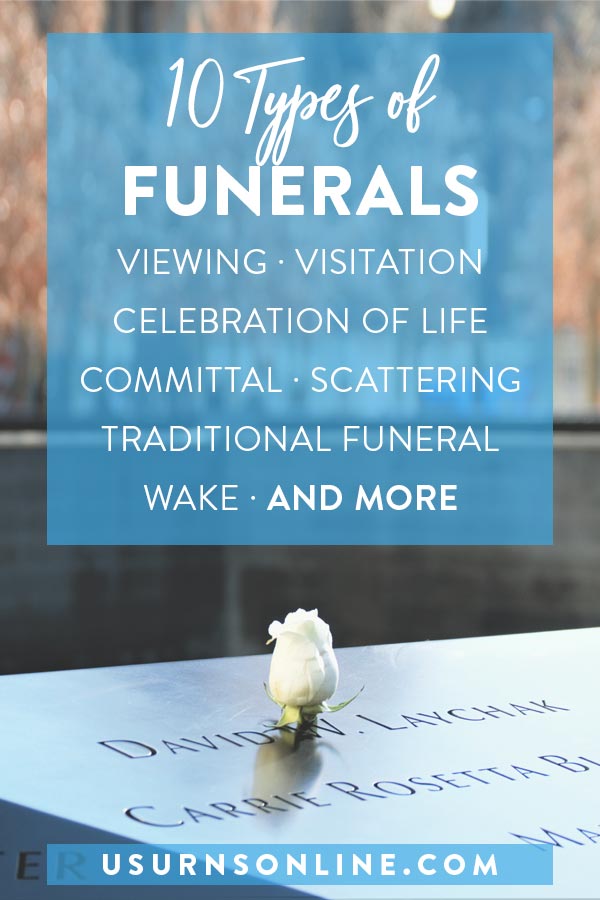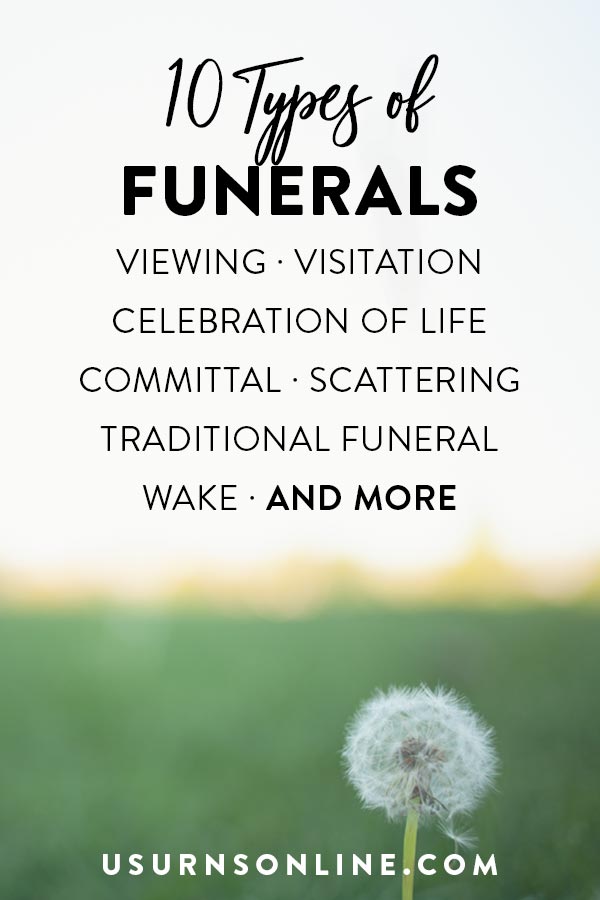In the United States, there are many different types of funeral services and ceremonies. It can be difficult to keep them all straight in your head, or even to differentiate between the various terms.
In this article, we hope to shed some light on 10 of the most common types of funeral services and related events in the English-speaking world. We’ll list and define each ceremony, and also add some detail on what to expect at each of them.
Our website is supported by our users. We sometimes earn a commission when you click through the affiliate links on our website. See our privacy policy & disclosures for more information.
10 Types of Funeral Services
Here are the ten types of funeral services:
- Funeral service
- Graveside or committal service
- Direct burial
- Direct cremation
- Memorial service
- Celebration of life
- Wake
- Viewing
- Visitation
- Scattering ceremony
Let’s take a look at each of these in turn.
What is a Traditional Funeral Service?
The traditional funeral service is still the most common type of funeral ceremony held in many parts of the country. At a traditional funeral service, the casket or urn is usually present.
Friends and family may sing or play songs in memory of the deceased, and someone may also deliver a eulogy. Traditional funerals are often religious in nature, so a pastor will most likely give a sermon.
A hearse will transport the remains to the cemetery for burial immediately following the traditional funeral, if there is a casket. There may or may not be a short graveside (or “committal”) service, at which the casket is buried or the urn is inurned. Following this, the family may host a reception or lunch in memory of their loved one.
The funeral service is typically preceded by a viewing or visitation (usually the night before), and followed by a graveside service. See below for more details on each of those types of funeral services.
What is a Graveside Service? (a.k.a. Committal Service)
A graveside service is a funeral ceremony that occurs at the cemetery, where family and friends pay their final respects before the casket is lowered into the ground for burial.
Urns Made in the USA
Because loved ones are committing the deceased back to the earth, this intimate service is also called a committal. A graveside service often follows a traditional funeral, but sometimes may be the only service a family chooses.
Often a pastor will speak a few words of comfort (think “ashes to ashes and dust to dust”) or the funeral director may share a few remarks at the wishes of the family, but otherwise this service is usually fairly short and simple.
For example, U.S. President Calvin Coolidge’s committal service contained the following:
- Rev. Penner commits Coolidge’s body to burial
- Poem: Warm Summer Sun, by Robert Richardson
- Benediction
- Silence
- TAPS
What is a Direct Burial?
Sometimes a family desires to bury their loved one, but does not plan a funeral or other formal ceremony. In this case, they may choose a direct burial option.
With direct burial, there is no visitation, funeral, or even graveside service. The funeral home simply buries the casket. The immediate family is typically present, and someone may say a few words, but the general idea is that direct burial is simpler.
Sometimes, a family will choose this type of funeral with plans for a memorial service at a later date. Learn more about direct burial here.
Direct burials are a more affordable option for the family that will not be having a formal funeral, but still wishes to have their loved one interred in a cemetery. Often, this happens when the family does not live near the decedent.
What is a Direct Cremation?
Similar to direct burial, direct cremation is a stand-alone event. It is simply a cremation; there is no formal visitation or funeral.
Following cremation, the funeral home or crematory returns the remains to the family, who may or may not choose to have a memorial service later on down the road.
Direct cremation is usually the least expensive option for final disposition. Read more about direct cremation here.
If you choose a direct cremation for your loved one, the funeral home or crematory will most likely return the remains to you in a very basic container. But you may choose to have the remains transferred into a permanent, more attractive urn (the facility serving you will be happy to do this for you).
Related: Every Type of Urn You Can Use
What is a Memorial Service?
The memorial service is one of the most common types of funeral services. It is very similar to a traditional funeral, with the exception being that the casketed body is not present. (Cremated remains in an urn may or may not be present.)
The beauty of memorial services is that they do not have to occur within a certain time frame following a death. The ceremony can happen a day after interment or inurnment, a year later, or whenever. The remains are not at the center of this service, only the precious memory of the deceased.
Read more: 34 Creative Memorial Service Ideas
What is a Celebration of Life?
A celebration of life is a unique ceremony unto its own. While it can take the place of a traditional funeral service, it’s common for the celebration of life to occur days, weeks, or even years following the funeral. This means that the remains are often not present. However, this can vary depending on the family’s preference.
Celebrations of life are exactly that: celebrations! Personalization is important in a celebration of life, and it is usually more joyful than somber.
Depending on the region and culture of the family, a celebration of life may include food, dancing, and happy memories shared of the deceased.
Related: 100 Inspirational Memorial Ideas for a Celebration of Life
What is a Wake?
A wake is the solemn service usually occurring just before the funeral. The origins of traditional wakes are in Catholicism, so the faithful may say the Rosary during the wake.
Traditionally, wakes take place in the home, but many funeral homes now serve as venue. People sometimes call wakes visitations or viewings. During the wake, loved ones come together to comfort one another and to pay their final respects to the deceased. The body or remains may or may not be present.
Learn everything your need to know about wakes here.
What is a Viewing?
The term viewing is often used interchangeably with wake and visitation, but it does have an official meaning all its own. It is fairly straightforward: at a viewing, the body is usually present to be viewed by mourners.
The funeral home usually hosts the viewing the night before the funeral service. Learn more about viewings here.
For information about “viewing” or watching the cremation (which is entirely different than a formal “viewing”), see this article on witnessing a cremation.
What is a Visitation?
As mentioned above, people generally use the terms visitation, wake, and viewing interchangeably. But the body is usually not present at the visitation, which most likely takes place at the funeral home or at the family’s home.
The emphasis of a visitation is placed on visiting with grieving family and friends, so it’s going to be less formal than the funeral. Drinks, dessert, appetizers, even a full potluck meal are all appropriate at a visitation. Read more about visitations here.
What is a Scattering Ceremony?
A scattering ceremony occurs when a family chooses to scatter the cremated remains of their loved one, rather than keep or bury them. Usually, the family scatters the ashes into the wind, at a location that was especially important to the deceased.
Scattering ceremonies can be simple or elaborate. The family may release the ashes silently and serenely into the ocean… or incorporate them into a spectacular firework display.
The ceremony itself is usually similar to a graveside or committal service. It is an appropriate time to say a few words to honor the departed loved one. Consider reading a favorite quote or Scripture, saying a prayer, or singing a hymn.
Keep in mind that, depending on the state you’re in, there are laws surrounding where ashes may be scattered.
Creating a Meaningful Funeral Ceremony
Regardless of what type of event you choose, you will need to make many of the same decisions regarding what to say, what to do with the body, and other accessories and options.
You’ll need to choose cremation or burial. The funeral director will ask you to pick a casket for your loved one. There are flowers to select, a funeral program to create,
You may be offered a catering option, for you and your guests to enjoy at a reception following the funeral and interment. You’ll need to choose a cemetery and purchase a plot. Or you’ll need to pick a memorial urn and also a date for cremation to take place.
Related: What Should Be Included in a Funeral Program?
Ways to Personalize the Ceremony
But for a more personalized funeral ceremony (even a traditional one), the options are virtually limitless! Many funeral homes today are more than happy to help you customize the service… in fact, many encourage it.
If your great aunt was an avid gardener and loved to spend all her time outside landscaping her yard, why not have her service reflect this? Choose an abundance of her favorite blooms to decorate her casket. Offer guests packets of gardening seeds or other similar favors to take back home with them and plant in her memory. Have a memory table filled with photos of her in happier days, working in her garden. Include the famous poem “God’s Garden” in her eulogy.
Maybe your brother has just passed away, but you know that he wouldn’t have wanted a traditional funeral. And you know that embalming is something he doesn’t want. In this case, you have the option of cremation, but keep in mind that embalming is not always necessary if you do not want to go that route. You may choose to have a direct burial for him, and then at a later date hold a memorial service or celebration of life.
Natural burial is gaining traction in many regions; you could opt for a beautiful outdoor ceremony for your loved one, sans embalming and even funeral director.
You could choose a biodegradable casket, or simply wrap the body in a shroud. A simple outdoor ceremony will be just as precious as any other – perhaps even more so.
There are so many other funeral options available. The beauty of realizing that you are in charge helps you recognize that you have so many wonderful things to consider.
Creative Ceremony Examples
Planning for a funeral is a lot of work, even with the help of a funeral director. Sometimes, it can help to have a few examples to look at for reference. So, besides the ones mentioned above, here are a few more ideas for you to think about.
Ceremony Ideas for a Young Child
Your nephew was only four when he passed away. He absolutely loved LEGO! The colorful bricks adorned his bedroom, and even his last birthday party had been LEGO-themed. Make sure you let the funeral director know this!
The funeral director may have a few tricks up their sleeve to make the funeral ceremony less of a sad event and more of a celebration of life.
Perhaps you’ll discover that you can get a LEGO-themed funeral program made. Perhaps even a casket or urn! Or maybe you can set up a brick-building activity center for any kids that attend the funeral. Adults love LEGO too, so consider a basket of bricks at each reception table.
Ceremony Ideas for a Pet Lover
Your mother’s little lap dog, Sugar, was her pride and joy! Sugar went with your mother everywhere, to the grocery store, to the park, and even at the hospital when the end was near.
So why not ensure that Sugar has a place of honor at the memorial for her mama?
Ask the funeral director about letting the fur baby come and join the other attendees in saying her final goodbyes. Include photos of your mom with her pup in the slideshow. Print the funeral programs with a canine theme. Bake paw-shaped sugar cookies for the reception.
Ceremony Ideas for a Biker
Your cousin was a motorcycle enthusiast. He had a passion for Harley-Davidson’s and his own Road King was his pride and joy.
Consider asking the funeral director to display your cousin’s bike next to the casket at the service, or perhaps at the visitation or viewing. You can find motorcycle-themed cremation urns and other items that are ideal for display at the funeral ceremony.
Ceremony Ideas for a Schoolteacher
Before she passed, your best friend from high school was working as a teacher herself at the very same high school you both attended. This fulfilled her lifelong dream of working at her alma mater while serving the community.
You think it’s a great idea to keep her life’s passion alive by decorating the funeral home with the school’s memorabilia. She also sang wonderfully, and worked with the school’s choir department. So ask the funeral director to play some recordings of her singing during the service.
Ceremony Ideas for Grandma
Grandma loved to quilt. Have some of her projects out on display throughout the funeral home. Invite attendees to bring a special scrap of fabric and make it into a memorial quilt.
Alternatively, give out some of Grandma’s scraps (I’m sure she has many!) as a memorial token for each person to take home.
Ceremony Ideas for a Fisherman
Grandpa’s favorite pastime was fishing. Have his casket spray incorporate his fishing rod and tackle box.
Get a “Gone Fishing” cremation urn (or other fishing-themed urns) and display photos of his best catches nearby.
Funeral Tips
Utilize the services of the funeral director! It’s their job to be there, to answer your questions and to help you with all of the details. Learn how to choose a good one here.
Ask for third-party help outside of the funeral home. It’s a good idea to have a fresh set of eyes or ears to help you get everything just right. For example, did you know that most funeral homes do not offer to help with the eulogy? We can help with that.
Get an idea of what to expect cost-wise. Did your loved one have life insurance? Was their funeral already pre-paid? Are payment arrangements an option? Learn more about funeral costs here.
Ask for help from a celebrant. Much like a wedding planner coordinates all the details of a wedding, a funeral director does much of the same for the funeral. But a celebrant could add a personal touch to your loved one’s service, from helping you decide on the day’s order of events to singing or speaking the eulogy.
Take time to take care of yourself. It’s probably the very last thing on your mind. You are in the midst of grief, and are also trying to plan the funeral ceremony for your loved one. But how can you do the best job you can without rest and fuel for the days ahead? Make sure that you are getting enough to eat and plenty of sleep. Here are 44 tips for self-care while grieving.
Write everything down. Each time a question pops in your head, and you think, “Oh, I need to ask the director about this,” write it down in a notebook. Because with everything else going on, you are sure to forget about it otherwise. Keep your notebook with you at all times, and the next time you talk with the director, you’ll have your questions ready to go.
Read next: 34+ Inspirational Memorial Service Ideas






It’s good to learn that a direct burial service is an affordable option for a funeral. My father is getting old and I was wondering how we could do a funeral for him when he passes away for cheap. I’ll be sure to remember to look for a direct burial service for when we need to do a funeral for him.